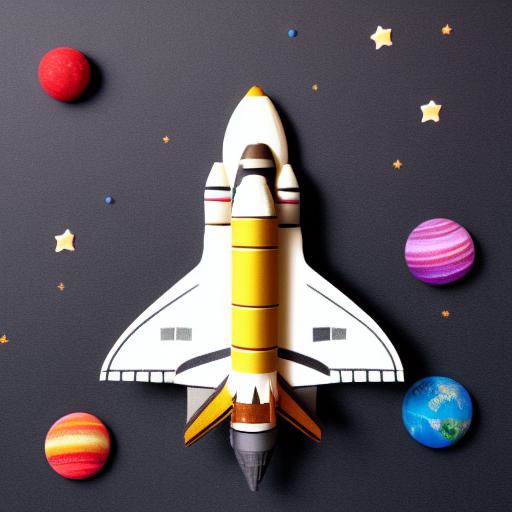How to write this prompt?
Create a prompt like this, you’ll want to break it down into its individual components and describe them in detail. Here’s a breakdown of the components of the prompt and how they might influence the generated image:
- Joyful layered paper art: This sets the tone and style for the image. The use of paper art implies that the image will have a handcrafted, textured look with layered elements. The use of the word “joyful” suggests that the image will have a positive and uplifting vibe.
- Space shuttle with different planets and earth: This is the subject matter of the image. The space shuttle implies a sense of adventure and exploration, while the planets and earth suggest a cosmic and otherworldly theme.
- Gradient background: This describes the background of the image. The use of a gradient implies a sense of depth and dimensionality, as well as a sense of movement or transition.
- Handicraft, paper sculpture, paper craft, paper art: These words reinforce the idea that the image will have a handmade and tactile quality, with a focus on the use of paper as a medium.
- Stars, space exploration: These additional keywords add to the overall theme of the image, suggesting a focus on the wonder and awe of space and the cosmos.
Each individual part of the prompt contributes to the overall image in different ways. For example, the use of paper art and handicraft techniques might lead the AI to create a layered, three-dimensional effect in the image. The focus on space exploration might result in the inclusion of stars and planets, while the use of a gradient background might create a sense of depth and motion in the image. By carefully choosing and describing each component of the prompt, you can guide the AI to create an image that matches your desired style and theme.
How did the layered paper art originated?
Layered paper art, also known as paper sculpture or paper crafting, has been around for centuries. It is believed to have originated in China during the Han Dynasty (202 BC – 220 AD), where paper was invented. The art form then spread to Japan, where it became known as origami, and to Europe, where it was used for religious and decorative purposes.
In the 20th century, artists like Henri Matisse and Pablo Picasso began incorporating paper cutting and collage techniques into their work, popularizing the use of paper as a medium for fine art. Today, layered paper art is still widely used for both artistic and practical purposes, such as creating greeting cards, decorations, and sculptures.
Is layered paper art popular around the world?
Yes, layered paper art is popular around the world, with many cultures developing their own unique styles and techniques. In addition to the origami tradition in Japan, there are paper-cutting traditions in China, Germany, and other countries. In Mexico, paper mache is a popular form of layered paper art used to create decorative objects and piñatas. In the United States, paper quilling is a popular form of layered paper art that involves rolling and shaping strips of paper into intricate designs.
How is space theme being used in graphic design nowadays?
The space theme has become increasingly popular in graphic design in recent years, with a focus on the exploration and wonder of the cosmos. Space-themed designs often feature images of planets, stars, galaxies, and astronauts, as well as futuristic typography and abstract shapes.
One trend in space-themed graphic design is the use of gradient backgrounds, which create a sense of depth and movement in the design. Another trend is the use of neon colors and retro-futuristic imagery, inspired by the aesthetics of 80s sci-fi films and video games. In addition, augmented reality (AR) and virtual reality (VR) technologies are being used to create immersive space-themed experiences for users.
What types of art can be generated using AI?
AI can generate a wide variety of art forms, including paintings, drawings, sculptures, and even music. One popular use of AI in art is to create generative art, which is created through a process of randomization and algorithmic manipulation. AI can also be used to generate abstract art, landscapes, portraits, and more.
Another use of AI in art is to assist artists in the creative process, providing suggestions and feedback based on patterns and trends in the artist’s work. This can help artists refine their techniques and develop new ideas.
Can AI-generated art be improved or edited by humans?
Yes, AI-generated art can be improved or edited by humans. While AI is capable of creating art on its own, it is still limited by its programming and the data it has been trained on. Human intervention can help to refine and improve the final output.
For example, an artist may use AI to generate a series of abstract designs, and then choose the most interesting or promising ones to further develop and refine by hand. Additionally, humans can provide feedback to AI algorithms, helping to improve their accuracy and effectiveness over time.
Looking to add some cutting-edge creativity to your designs? Look no further than Visual Paradigm Online! With our innovative design tools, you can seamlessly incorporate stunning AI-generated art into your graphics with just a few clicks. Our user-friendly interface and extensive range of design templates and assets make experimentation a breeze, so you can explore countless styles and layouts until you find the perfect combination for your project. Elevate your designs to the next level with Visual Paradigm Online today!


